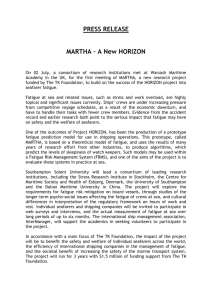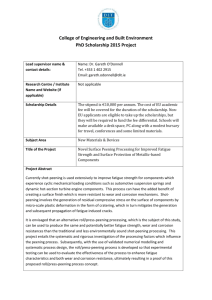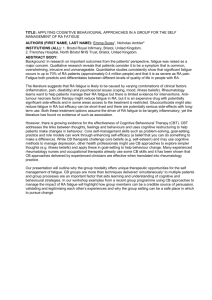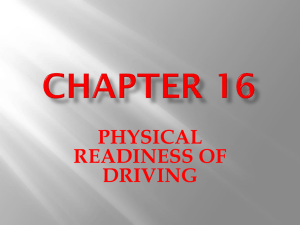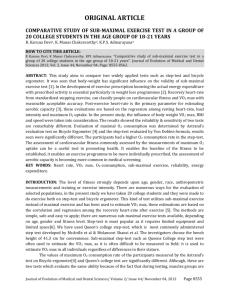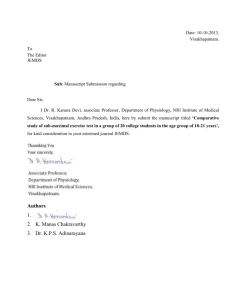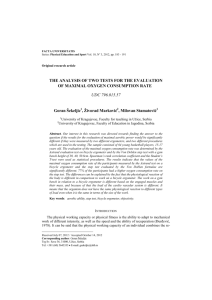Sample manuscript for repeated measures design
advertisement
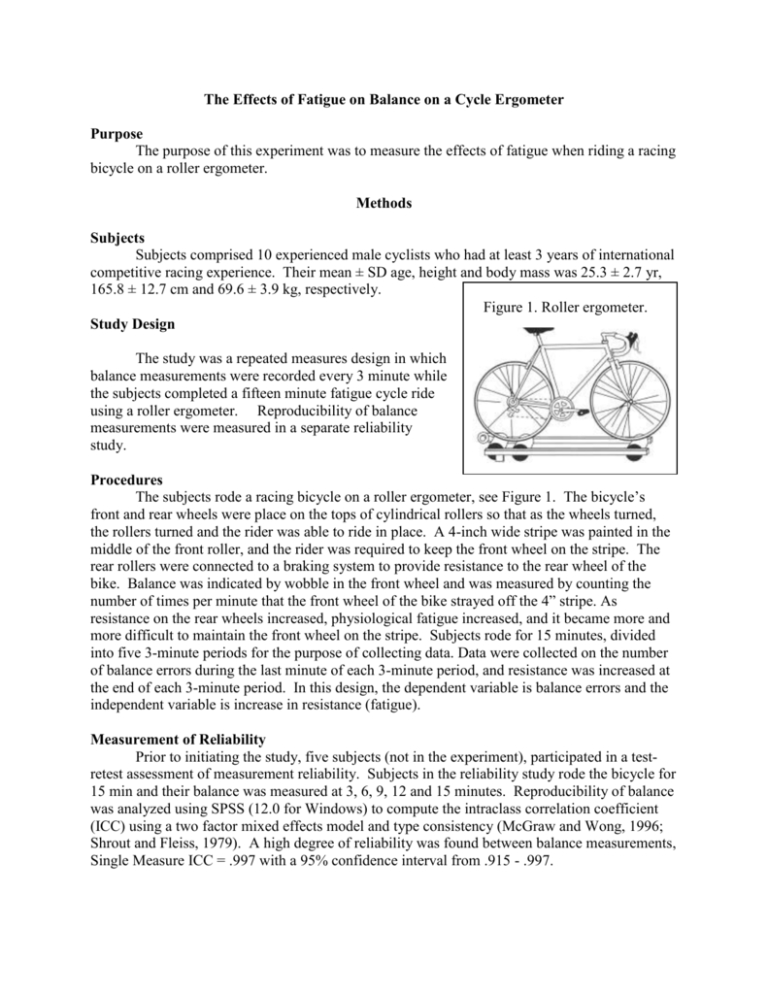
The Effects of Fatigue on Balance on a Cycle Ergometer
Purpose
The purpose of this experiment was to measure the effects of fatigue when riding a racing
bicycle on a roller ergometer.
Methods
Subjects
Subjects comprised 10 experienced male cyclists who had at least 3 years of international
competitive racing experience. Their mean ± SD age, height and body mass was 25.3 ± 2.7 yr,
165.8 ± 12.7 cm and 69.6 ± 3.9 kg, respectively.
Figure 1. Roller ergometer.
Study Design
The study was a repeated measures design in which
balance measurements were recorded every 3 minute while
the subjects completed a fifteen minute fatigue cycle ride
using a roller ergometer. Reproducibility of balance
measurements were measured in a separate reliability
study.
Procedures
The subjects rode a racing bicycle on a roller ergometer, see Figure 1. The bicycle’s
front and rear wheels were place on the tops of cylindrical rollers so that as the wheels turned,
the rollers turned and the rider was able to ride in place. A 4-inch wide stripe was painted in the
middle of the front roller, and the rider was required to keep the front wheel on the stripe. The
rear rollers were connected to a braking system to provide resistance to the rear wheel of the
bike. Balance was indicated by wobble in the front wheel and was measured by counting the
number of times per minute that the front wheel of the bike strayed off the 4” stripe. As
resistance on the rear wheels increased, physiological fatigue increased, and it became more and
more difficult to maintain the front wheel on the stripe. Subjects rode for 15 minutes, divided
into five 3-minute periods for the purpose of collecting data. Data were collected on the number
of balance errors during the last minute of each 3-minute period, and resistance was increased at
the end of each 3-minute period. In this design, the dependent variable is balance errors and the
independent variable is increase in resistance (fatigue).
Measurement of Reliability
Prior to initiating the study, five subjects (not in the experiment), participated in a testretest assessment of measurement reliability. Subjects in the reliability study rode the bicycle for
15 min and their balance was measured at 3, 6, 9, 12 and 15 minutes. Reproducibility of balance
was analyzed using SPSS (12.0 for Windows) to compute the intraclass correlation coefficient
(ICC) using a two factor mixed effects model and type consistency (McGraw and Wong, 1996;
Shrout and Fleiss, 1979). A high degree of reliability was found between balance measurements,
Single Measure ICC = .997 with a 95% confidence interval from .915 - .997.
A Priori Statistical Power Analysis
Based on initial pilot testing of five subjects (or existing published data), we determined a
practical statistical significant difference in balance of 12 ± 11. For this design, 11 subjects
would be required to obtain 0.80 statistical power (Cohen, 1988).
Statistical Analysis
Data were analyzed using SPSS version 12.0.1 for Windows. Values are expressed as
means ± SD. The distribution of each variable was examined with the Kolomogorov-Smirnov
and Shapiro-Wilk normality tests. A single factor repeated measures ANOVA was performed to
detect significant differences in balance by levels of fatigue (3, 6, 9, 12 and 15 minutes). Level
of fatigue (time in minutes) was a within subjects factor. Follow-up tests of significant ANOVA
effects were compared using the Tukey post hoc test. The level of significance was set at P <
0.05.
Results
The means ± SDs for balance by level of fatigue (3, 6, 9, 12 & 15 min) are shown in
Figure 2. The K-S and S-W tests of normality indicated that the variables were normally
distributed. Mauchly’s test of sphericity indicated that the assumption of sphericity was violated,
therefore, the degrees of freedom for all ANOVAs were adjusted using the Greenhouse-Geisser
adjustment. The level of fatigue significantly effected balance when riding a racing bicycle on a
roller ergometer [F(1.485, 13.367) = 18.36, p = 0.000, observed power = .995, effect size or
partial η2 = .67]. {Note: without using the G-G adjustment the stats would have been F(4,36) =
18.36, p = 0.000, observed power = 1.000, effect size or partial η2 = .67} As shown in Figure 1, a
significantly greater number of balance errors occurred at 12 min (31.1 ± 12.6) than: 9 min (16.4
± 10.8), 6 min (11.4 ± 7.96) and 3 min (8.5 ± 4.5). The number of balance errors at 15 min (36.5
± 21.1) was significantly greater than: 9 min (16.4 ± 10.8), 6 min (11.4 ± 7.96) and 3 min (8.5 ±
4.5). No other pairwise comparisons were significant.
70
Figure 2
Balance Errors
60
50
40
a,b
30
a,b
20
a,b
10
0
0
5
10
15
20
Minutes of Exercise
a
indicates means are significantly different from 12 minutes.
indicates means are significantly different from 15 minutes
p < 0.05
b
Tables and Figures should ALWAYS have a note indicating
groups (means) that are significantly different, even if there are
NO SIGNIFICANT DIFFERENCES.
References
Cohen J. Statistical Power Analysis for the Behavioral Sciences, Lawrence Erlbaum Associates:
Hillsdale, NJ, 1988.
McGraw KO and Wong SP. Forming inferences about some intraclass correlation coefficients.
Psychological Methods 1: 30-46, 1996.
Shrout PE and Fleiss JL. Intraclass correlations: Uses in assessing reliability. Psychol Bull 86:
420-428, 1979.


